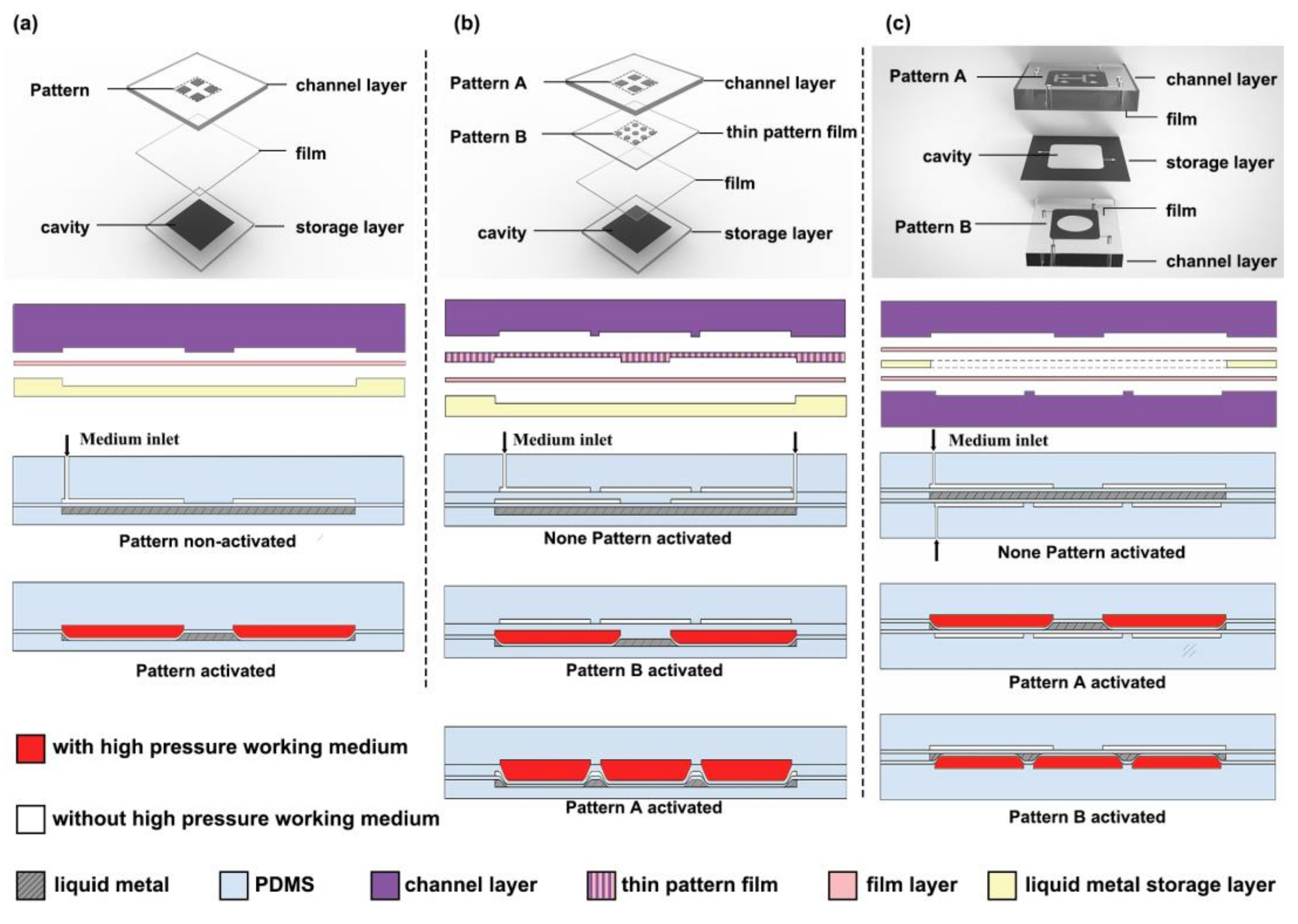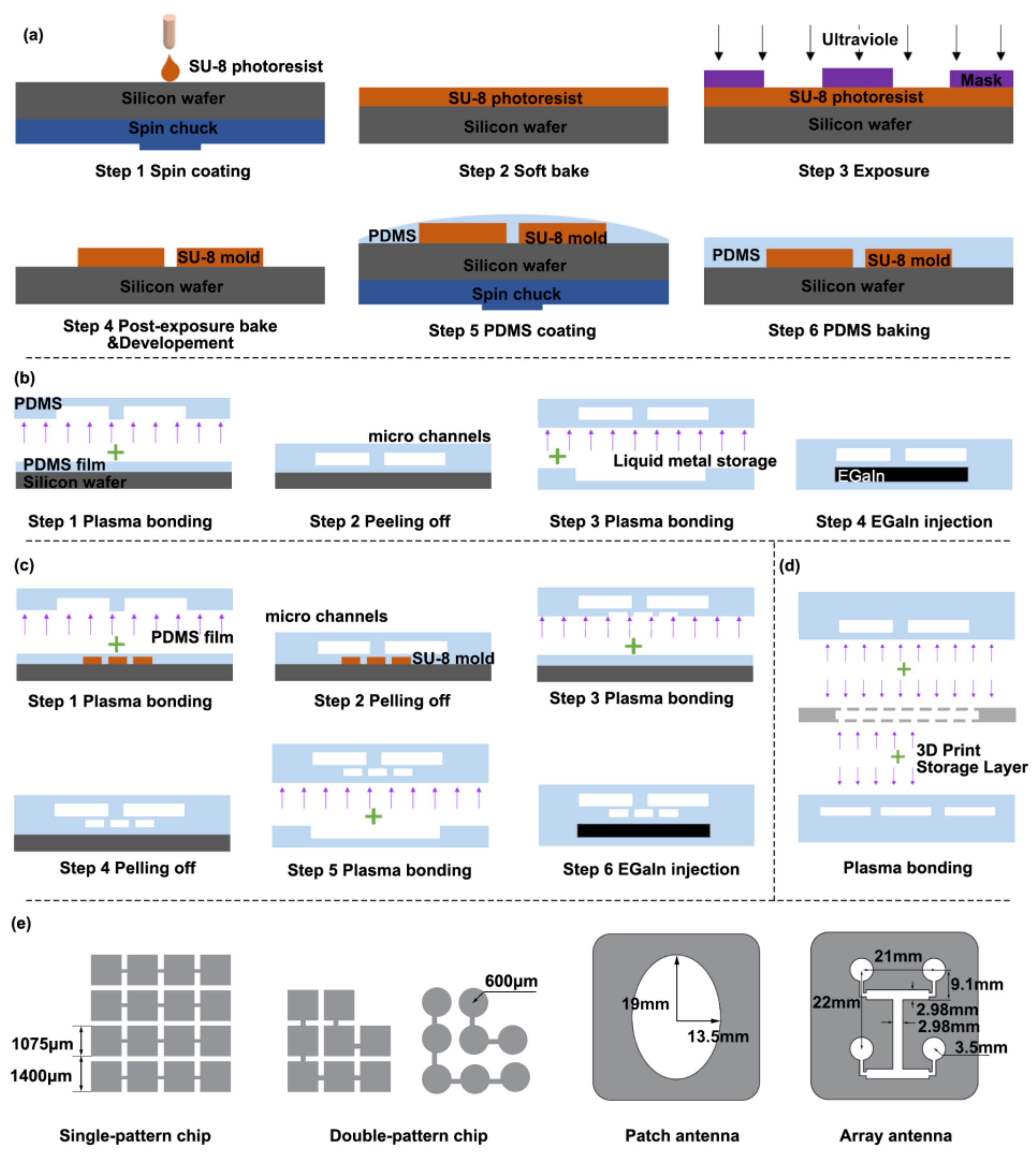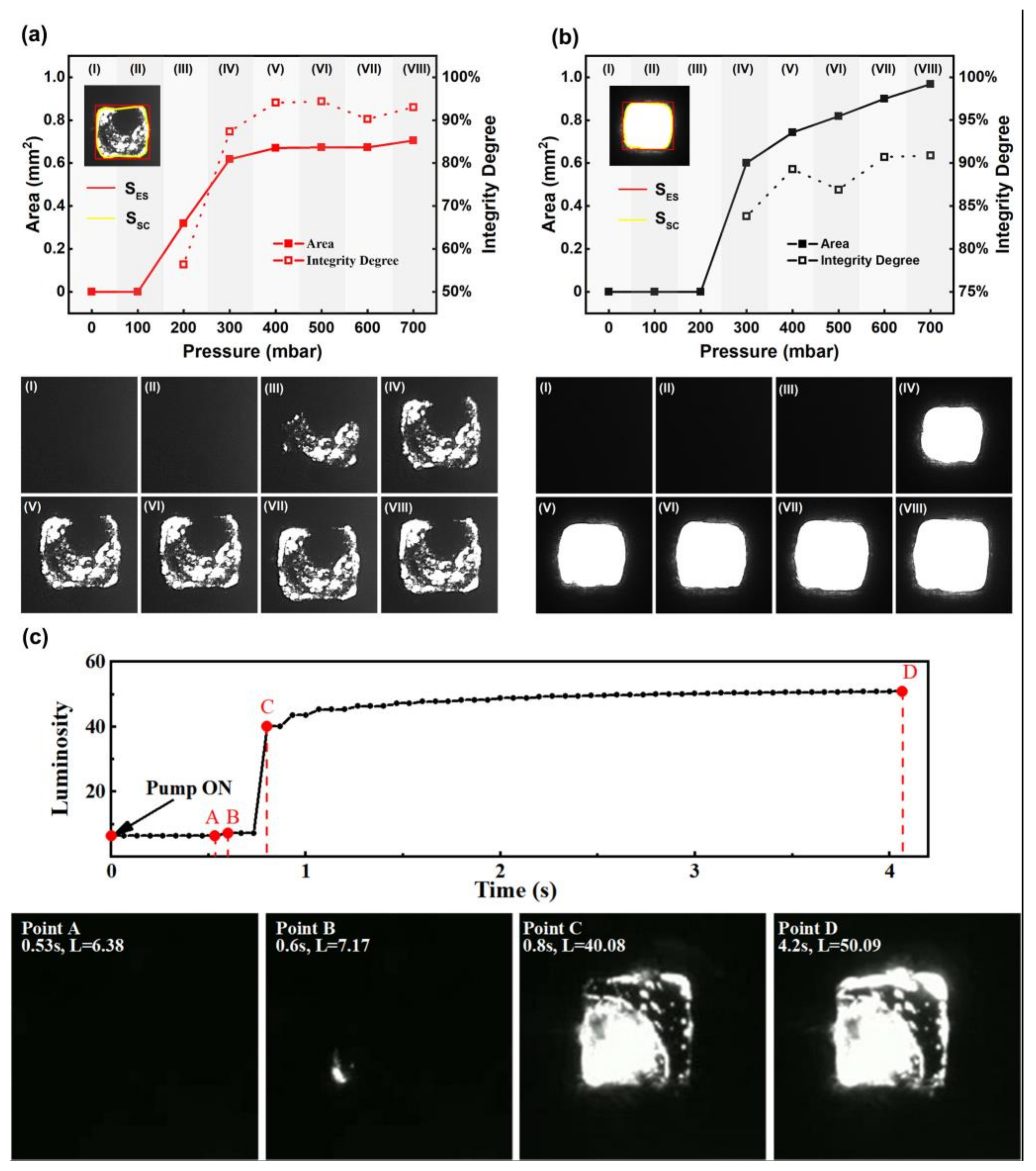Pressure Driven Rapid Reconfigurable Liquid Metal Patterning
Abstract
:1. Introduction
2. Working Mechanism
3. Materials and Methods
4. Results
4.1. Pressure Effect on Patterning
4.2. Time Efficiency of the Method
4.3. Structural Size Effect on Patterning
4.4. Reconfiguring Test
5. Application
6. Conclusions
7. Patents
Supplementary Materials
Author Contributions
Funding
Data Availability Statement
Conflicts of Interest
Appendix A
| Matlab program for luminosity |
| img_origin = imread(‘xxx.png); pc_gray = rgb2gray(jpg); I_db = double(pc_gray); |
References
- Shembekar, N.; Chaipan, C.; Utharala, R.; Merten, C.A. Droplet-based microfluidics in drug discovery, transcriptomics and high-throughput molecular genetics. Lab. Chip 2016, 16, 1314–1331. [Google Scholar] [CrossRef] [PubMed] [Green Version]
- Arora, A.; Simone, G.; Salieb-Beugelaar, G.B.; Kim, J.T.; Manz, A. Latest Developments in Micro Total Analysis Systems. Anal. Chem. 2010, 82, 4830–4847. [Google Scholar] [CrossRef] [PubMed]
- Hansen, C. Microfluidics in structural biology: Smaller, faster… better. Curr. Opin. Struc Biol. 2003, 13, 538–544. [Google Scholar] [CrossRef] [PubMed]
- Reeder, J.T.; Xie, Z.; Yang, Q.; Seo, M.; Yan, Y.; Deng, Y.; Jinkins, K.R.; Krishnan, S.R.; Liu, C.; McKay, S.; et al. Soft, bioresorbable coolers for reversible conduction block of peripheral nerves. Science 2022, 377, 109–115. [Google Scholar] [CrossRef] [PubMed]
- Sackmann, E.K.; Fulton, A.L.; Beebe, D.J. The present and future role of microfluidics in biomedical research. Nature 2014, 507, 181–189. [Google Scholar] [CrossRef]
- Cheng, S.; Wu, Z. Microfluidic electronics. Lab. Chip 2012, 12, 2782. [Google Scholar] [CrossRef]
- Morley, N.B.; Burris, J.; Cadwallader, L.C.; Nornberg, M.D. GaInSn usage in the research laboratory. Rev. Sci. Instrum. 2008, 79, 56107. [Google Scholar] [CrossRef] [Green Version]
- Joshipura, I.D.; Ayers, H.R.; Majidi, C.; Dickey, M.D. Methods to pattern liquid metals. J. Mater. Chem. C 2015, 3, 3834–3841. [Google Scholar] [CrossRef]
- Gozen, B.A.; Tabatabai, A.; Ozdoganlar, O.B.; Majidi, C. High-Density Soft-Matter Electronics with Micron-Scale Line Width. Adv. Mater. 2014, 26, 5211–5216. [Google Scholar] [CrossRef]
- Kramer, R.K.; Majidi, C.; Wood, R.J. Masked Deposition of Gallium-Indium Alloys for Liquid-Embedded Elastomer Conductors. Adv. Funct. Mater. 2013, 23, 5292–5296. [Google Scholar] [CrossRef]
- Li, G.; Wu, X.; Lee, D. Selectively plated stretchable liquid metal wires for transparent electronics. Sens. Actuators B Chem. 2015, 221, 1114–1119. [Google Scholar] [CrossRef]
- Lu, T.; Finkenauer, L.; Wissman, J.; Majidi, C. Rapid Prototyping for Soft-Matter Electronics. Adv. Funct. Mater. 2014, 24, 3351–3356. [Google Scholar] [CrossRef]
- Calvert, P. Inkjet Printing for Materials and Devices. Chem. Mater. 2001, 13, 3299–3305. [Google Scholar] [CrossRef]
- Hon, K.K.B.; Li, L.; Hutchings, I.M. Direct writing technology—Advances and developments. CIRP Ann. 2008, 57, 601–620. [Google Scholar] [CrossRef]
- Jeong, S.H.; Hagman, A.; Hjort, K.; Jobs, M.; Sundqvist, J.; Wu, Z. Liquid alloy printing of microfluidic stretchable electronics. Lab. Chip 2012, 12, 4657. [Google Scholar] [CrossRef]
- Wang, L.; Liu, J. Printing low-melting-point alloy ink to directly make a solidified circuit or functional device with a heating pen. Proc. R. Soc. A Math. Phys. Eng. Sci. 2014, 470, 20140609. [Google Scholar] [CrossRef]
- Wang, L.; Liu, J. Ink Spraying Based Liquid Metal Printed Electronics for Directly Making Smart Home Appliances. ECS J. Solid. State Sci. Technol. 2015, 4, P3057–P3062. [Google Scholar] [CrossRef] [Green Version]
- Wang, L.; Liu, J. Liquid phase 3D printing for quickly manufacturing conductive metal objects with low melting point alloy ink. Sci. China Technol. Sci. 2014, 57, 1721–1728. [Google Scholar] [CrossRef]
- Boley, J.W.; White, E.L.; Chiu, G.T.C.; Kramer, R.K. Direct Writing of Gallium-Indium Alloy for Stretchable Electronics. Adv. Funct. Mater. 2014, 24, 3501–3507. [Google Scholar] [CrossRef]
- Siegel, A.C.; Bruzewicz, D.A.; Weibel, D.B.; Whitesides, G.M. Microsolidics: Fabrication of Three-Dimensional Metallic Microstructures in Poly(dimethylsiloxane). Adv. Mater. 2007, 19, 727–733. [Google Scholar] [CrossRef]
- Cumby, B.L.; Hayes, G.J.; Dickey, M.D.; Justice, R.S.; Tabor, C.E.; Heikenfeld, J.C. Reconfigurable liquid metal circuits by Laplace pressure shaping. Appl. Phys. Lett. 2012, 101, 174102. [Google Scholar] [CrossRef] [Green Version]
- Rashed Khan, M.; Hayes, G.J.; So, J.; Lazzi, G.; Dickey, M.D. A frequency shifting liquid metal antenna with pressure responsiveness. Appl. Phys. Lett. 2011, 99, 13501. [Google Scholar] [CrossRef]
- Kim, H.; Son, C.; Ziaie, B. A multiaxial stretchable interconnect using liquid-alloy-filled elastomeric microchannels. Appl. Phys. Lett. 2008, 92, 11904. [Google Scholar] [CrossRef] [Green Version]
- Tang, R.; Zhang, C.; Liu, B.; Jiang, C.; Wang, L.; Zhang, X.; Huang, Q.; Liu, J.; Li, L. Towards an artificial peripheral nerve: Liquid metal-based fluidic cuff electrodes for long-term nerve stimulation and recording. Biosens. Bioelectron. 2022, 216, 114600. [Google Scholar] [CrossRef] [PubMed]
- Vetrovec, J. Quasi-Passive Heat Sink for High-Power Laser Diodes. In High-Power Diode Laser Technology and Applications VII; SPIE: Bellingham, WA, USA, 2009; Volume 7198, p. 71980D. [Google Scholar]
- Park, Y.; Majidi, C.; Kramer, R.; Bérard, P.; Wood, R.J. Hyperelastic pressure sensing with a liquid-embedded elastomer. J. Micromech. Microeng. 2010, 20, 125029. [Google Scholar] [CrossRef] [Green Version]
- Pekas, N.; Zhang, Q.; Juncker, D. Electrostatic actuator with liquid metal–elastomer compliant electrodes used for on-chip microvalving. J. Micromech. Microeng. 2012, 22, 97001. [Google Scholar] [CrossRef]
- Huang, Y.A.; Wang, Y.Z.; Xiao, L.; Liu, H.M.; Dong, W.T.; Yin, Z.P. Microfluidic serpentine antennas with designed mechanical tunability. Lab. Chip 2014, 14, 4205–4212. [Google Scholar] [CrossRef]
- Lin, Y.; Gordon, O.; Khan, M.R.; Vasquez, N.; Genzer, J.; Dickey, M.D. Vacuum filling of complex microchannels with liquid metal. Lab. Chip 2017, 17, 3043–3050. [Google Scholar] [CrossRef]
- Wang, R.H.; Gui, L.; Zhang, L.J.; He, Z.Z.; Gao, M.; Chen, S.; Zhou, X.Y.; Cui, Y.T.; Deng, Z.S. Porous Membrane-Enabled Fast Liquid Metal Patterning in Thin Blind-Ended Microchannels. Adv. Mater. Technol. 2019, 4, 1900256. [Google Scholar] [CrossRef]
- Ye, Z.; Li, Q.; Zhang, R.; Zhangab, P.; Gui, L. Fabrication of a thin PDMS film with complex liquid metal electrodes embedded and its application as skin sensors. RSC Adv. 2022, 12, 8290–8299. [Google Scholar] [CrossRef]
- Khan, M.R.; Trlica, C.; So, J.; Valeri, M.; Dickey, M.D. Influence of Water on the Interfacial Behavior of Gallium Liquid Metal Alloys. ACS Appl. Mater. Inter. 2014, 6, 22467–22473. [Google Scholar] [CrossRef]
- Dickey, M.D.; Chiechi, R.C.; Larsen, R.J.; Weiss, E.A.; Weitz, D.A.; Whitesides, G.M. Eutectic Gallium-Indium (EGaIn): A Liquid Metal Alloy for the Formation of Stable Structures in Microchannels at Room Temperature. Adv. Funct. Mater. 2008, 18, 1097–1104. [Google Scholar] [CrossRef]
- Khan, M.R.; Trlica, C.; Dickey, M.D. Recapillarity: Electrochemically Controlled Capillary Withdrawal of a Liquid Metal Alloy from Microchannels. Adv. Funct. Mater. 2015, 25, 671–678. [Google Scholar] [CrossRef]
- Qin, P.; Wang, L.; Liu, T.; Wang, Q.; Fu, J.; Huang, G.; Gui, L.; Liu, J.; Deng, Z. The Design and Manufacturing Process of an Electrolyte-Free Liquid Metal Frequency-Reconfigurable Antenna. Sensors 2021, 21, 1793. [Google Scholar] [CrossRef]
- Gong, J.H.; Wang, Q.F.; Liu, B.X.; Zhang, H.M.; Gui, L. A Novel On-Chip Liquid-Metal-Enabled Microvalve. Micromachines 2021, 12, 1051. [Google Scholar] [CrossRef]
- Yang, X.; Liu, Y.; Lei, H.; Jia, Y.; Zhu, P.; Zhou, Z. A Radiation Pattern Reconfigurable Fabry–Perot Antenna Based on Liquid Metal. IEEE Trans. Antenn. Propag. 2020, 68, 7658–7663. [Google Scholar] [CrossRef]
- Liu, M.; Sun, J.; Sun, Y.; Bock, C.; Chen, Q. Thickness-dependent mechanical properties of polydimethylsiloxane membranes. J. Micromech. Microeng. 2009, 19, 35028. [Google Scholar] [CrossRef]






| Height of SU-8 Mold (μm) | SU-8 Series | Spin-Coating Speed (rpm) | Exposure Time (s) |
|---|---|---|---|
| 30 | 2050 | 3000 | 8 |
| 100 | 2075 | 1500 | 10 |
| 200 | 2075 | 1000 | 12 |
| PDMS Film Thickness (μm) | Spin-Coating Speed (rpm) | Spin-Coating Time (min) |
|---|---|---|
| 22 | 3000 | 2 |
| 31 | 2500 | 2 |
| 39 | 2000 | 2 |
| 51 | 1500 | 2 |
| Type Frequency (GHz) | Frequency (GHz) | Operating Frequency Band (GHz) | Bandwidth (MHz) |
|---|---|---|---|
| Patch antenna | 5 | 4.93−5.07 | 140 |
| Array antenna | 10 | 9.83−10.22 | 390 |
Disclaimer/Publisher’s Note: The statements, opinions and data contained in all publications are solely those of the individual author(s) and contributor(s) and not of MDPI and/or the editor(s). MDPI and/or the editor(s) disclaim responsibility for any injury to people or property resulting from any ideas, methods, instructions or products referred to in the content. |
© 2023 by the authors. Licensee MDPI, Basel, Switzerland. This article is an open access article distributed under the terms and conditions of the Creative Commons Attribution (CC BY) license (https://creativecommons.org/licenses/by/4.0/).
Share and Cite
Liu, B.; Qin, P.; Liu, M.; Liu, W.; Zhang, P.; Ye, Z.; Deng, Z.; Li, Z.; Gui, L. Pressure Driven Rapid Reconfigurable Liquid Metal Patterning. Micromachines 2023, 14, 717. https://doi.org/10.3390/mi14040717
Liu B, Qin P, Liu M, Liu W, Zhang P, Ye Z, Deng Z, Li Z, Gui L. Pressure Driven Rapid Reconfigurable Liquid Metal Patterning. Micromachines. 2023; 14(4):717. https://doi.org/10.3390/mi14040717
Chicago/Turabian StyleLiu, Bingxin, Peng Qin, Mingyang Liu, Wei Liu, Pan Zhang, Zi Ye, Zhongshan Deng, Zhenming Li, and Lin Gui. 2023. "Pressure Driven Rapid Reconfigurable Liquid Metal Patterning" Micromachines 14, no. 4: 717. https://doi.org/10.3390/mi14040717





